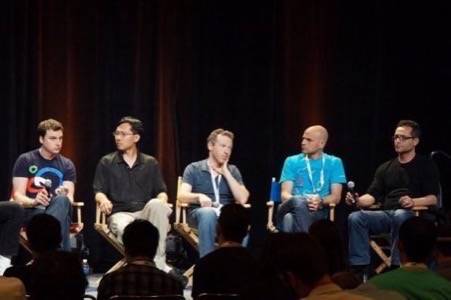One year in, Google is flying the banner of Google+ higher by the day. But what’s next? Last week at Google I/O, the Google+ platform team met onstage for a fireside chat, fielding developer frustrations and hinting heavily at how Google’s plans for its social network might be bigger than anyone had imagined.
Here are some highlights from the Google+ Platform Team fireside chat. The talk, moderated by Google engineer David Glazer, was a summit between Google+ Circles engineer Joseph Smarr, VP of Product Management for Google+ Bradley Horowitz, and a few other members of Google’s social side. With a patient, Apple-like eye for perfection, refinement and the big picture, the Google+ team discussed why it’s handling its year-old social network with kid gloves.
How Google+ Will Cure What Ails Google
Google is big. At Google I/O, it was more apparent than ever that many product teams operate separately in “silos,” as Horowitz calls them. Because of the company’s breadth and voracious acquisition appetite, Google sometimes steps on its own toes, like it did with Slide-built Pool Party, a now-defunct social photo-sharing app it acquired in 2010. At I/O, the Nexus Q is just another example of something puzzlingly separate from a next-door-neighbor product, in this case Google TV. With the advent of Google+, the company is now feeling those tensions at the social level, too.

Horowitz: “One of the things I think we could have done better at is thinking more holistically about an endgame. I think even down to our management structure, it didn’t really support any initiatives that wanted to knit together any of these products so that they were more than the sum of the parts. I think Google+ plays a great role in providing that. We’re sort of fixing what’s broken about Google and providing something really special as a result.”
Smarr: “We’re trying to unify Google; right now, there’s lots of fairly separate products that are trying to get unified.”
Horowitz: “There are so many different touchpoints to connect to a person. There’s no good way to do that at Google – you have to do a tremendous amount of effort across our products. This is not a feature, this is a tragic bug – and one of the things that Google+ can do is provide that social spine… that gives you a simple, coherent place to express who you are, who you know and what you care about.”
Why Developers Still Don’t Have a Google+ API
The panel had a palpable tone of tamped-down excitement as hungry developers pressed the team for details about the Google+ API. The API is now available to high-profile app partner Flipboard but remains closed to the public. Google intends to tide developers over with access to the toolkit for its History feature, which will infuse Google+ with a Facebook Timeline-like string of highlighted events.
Q: When will the full API for Google+ be available for everyone?
Glazer: “We deeply wanted to be sure we were building a platform that worked for developers. And at the same time, we knew there were a couple of failure modes around doing that. The obvious failure mode is ‘don’t give you tools.’ That’s an easy one to avoid, and this question is saying ‘I want more tools’ – understood.
“But there are some other failure modes we’ve seen out there, and one of them is to provide tools before we know if it’s a good idea and then to change our mind, and then to change our mind again, and then to change our mind again. The other failure mode we’ve seen is that it’s possible with a platform that has insufficient guidelines or tone or doesn’t nudge the experience in the right direction to build something that creates a tragedy of the commons, where the more [that] people build on the platform, the more it hurts the overall community. Once we know what sticks, we’re comfortable opening up more widely.”
Horowitz: “We have a very high velocity team. You don’t want to be chasing after a moving target.”
Fixing and Twitterizing Google+
According to Horowitz, “It’s not fun being late to market, but it does afford you certain advantages.” Google harvested the complaints around privacy and came up with Circles. Now, the team is studying bookmarking systems that could help Google+ users mark bits of the social stream for later.
Q: Is there going to be any way of bookmarking posts or threads?
Glazer: “I use exactly the same kind of workarounds that you’re talking about. That’s a pain point that several of us on the team have felt.”
Smarr: I would say it’s also just something that the Web needs in general. I use Instapaper; I try to bookmark stuff. I try to leave tabs open and then use Chrome to pull stuff across. None of it really works very well. That consumption pattern doesn’t necessarily fit; it doesn’t remind you, ‘Oh, here’s a little bit of idle time, here’s the stuff you could be reading.’
We often talked about, ‘Oh, should we build a starred post, so you could go back and see a stream of starred posts.’ But it actually isn’t really Google+ specific so much as there’s way too much stuff… there’s no kind of good GTD solution for the Web. I hope people can help build that.”
When it comes to the problem of juggling multiple Google accounts, “It’s not you, it’s us.” On a personal level, the team onstage admitted to wrestling with the same tangle of profile issues that many of its users have grown frustrated with. Search is useful, but still has its blindspots. Surprisingly, Horowitz seemed to entertain the idea of Twitter-like Google+ handles that go beyond the 21-digit numeric codes that identify users now – ones that’d be a lot easier to swap at a party. But don’t expect that (or any of the other social improvements on deck) too soon. The Google+ team continues to think big picture, while rolling in fixes and updates once they’re up to snuff.
“We feel the magic in our system,” said Horowitz. “Part of our tentative nature around this is ensuring that we get it right, and making sure that this experience isn’t compromised. We all feel like we’re sort of walking down the aisle with this golden egg… and we don’t want to screw it up.”










